No products
Prices are tax included
OCULUS 6200MC Pro (ToupTek SkyEye62AC - Color, IMX455)
OCULUS 6200MC Pro
New product
OCULUS 6200MC Pro (ToupTek SkyEye62AC - Color, IMX455)
Subject to availability from the supplier. Please contact us for more information.
More info
OCULUS 6200MC Pro (ToupTek SkyEye62AC - Color, IMX455)
These exceptional cameras feature the latest ultra-high resolution and high sensitivity Sony IMX455 CMOS sensor. They provide exceptional image quality and are widely used in astronomy, scientific research and industry. They are cooled and offer ultra-low read noise and non-existent AMPL-GLOW – truly exceptional performance. This camera is available in color (*-AC) and monochrome (*-AM) formats. The camera shown here is the color version.
Astromanie, being in close collaboration with the manufacturer of the SkyEye62 camera, will provide all the necessary after-sales service that the buyer may need.
We provide the SkyEye62 under the name OCULUS 6200MC Pro.
Thermoelectric cooling: The Peltier cooling system reduces image noise. Noise caused by dark current has almost completely disappeared at up to 35°C below ambient temperature. In addition, the exact control of the sensor temperature is very helpful for calibrating the astrophotos with dark frames: they can all be taken at the correct temperature. The low-noise images show more details and require less post-processing.
USB hub: Via two additional USB 2.0 ports on the back of the camera, additional devices (for example a guiding camera) can easily be connected to this hub. An additional cable connection from your PC to each individual device is therefore not necessary.
Connection: The camera can be adapted to almost any telescope - with an M54x0.75(f) thread and the back focus of 17.5 mm. M48x0.75(f) adapters and an extension for the usual 55mm backfocus are also included. A T2 adapter ring completes the connection options. The 2" outer diameter of the adapters allows of course a telescope connection like any standard 2" eyepiece.
The supplied robust case is filled with foam. Thus the camera is very well protected during any transport. If the camera should ever be separated from the telescope again.
Transmission: A filter protects the sensor chamber from dust and moisture. The Topuptek colour CMOS cameras are equipped with an infrared blocking filter. CMOS sensors are also sensitive to incident infrared light, making correct colour reproduction impossible. In contrast, Topuptek mono CMOS cameras have an anit-reflective protective glass that transmits ultraviolet and infrared light in addition to visible light. This allows complete control over the transmission curve through the use of additional filters - a prerequisite for advanced photographic or photometric applications.
Practical camera software: The downloadable ToupSky software enables uncomplicated and comprehensive camera control. ToupSky allows full control over all essential parameters - without an overburdening interface. The software is compatible with Windows 8/10/11.
Compatibility: Touptek cameras can be controlled by a wide range of recording software via the common ASCOM and INDI interfaces as well as AStro Dshow drivers. Native compatibility with a growing number is available with popular programs such as PHD2 and N.I.N.A.
TEC-Cooled USB 3.0 full frame color astro camera with powerful 24x36 mm sensor for top class astrophotography
- IMX 410 Color CMOS Sensor
- Resolution: 9568 x 6380
- 3.76 um Square Pixels
- Full Frame Optical Format
- 16-bitADC
- 512 Mbyte Memory Onboard
- PreciseTemperatureRegulation
- ZeroAmp-Glow
- Sensitivity:484.18mVwith1/30s
- Ultra-Low Noise: 0.89 to 1.72 e- (Low Noise Mode)
- Support Low Noise Mode/ High Frame Rate Mode (6.2 FPS at all Pixel Readout 8 bit)
- Support HCG Mode/ LCG Mode
- SNR Max: 47.0 dB (Low Noise Mode)
- Dynamic Range: 85.8 dB (Low Noise Mode)
- -30°C below Ambient under Short Exposure/ -35°C under Long Exposure Time (> 1s)
Spezifications
|
Sensor: |
Sony CMOS IMX455 |
|
|
Diagonal |
43.3 mm |
|
|
Sensor size: |
35.976 mm x 23.989 mm |
|
|
Resolution |
61 mega pixels, 9568 x 6380 |
|
|
Pixel size: |
3.76 µm x 3.76 µm |
|
|
Spectral range |
380-690nm (with IR-cut Filter) |
|
|
ADC: |
16 bit native |
|
|
Cooling: |
- Two-stage TE-cooling System 30-35 °C below Ambient Temperature - 35 K below ambient under short exposure - 35 K under long exposure time (> 1s) |
|
|
Heating |
- integrated heating against condensation - the sensor chamber is hermetically sealed - there are desiccants in the sensor chamber |
|
|
Sensitivity |
The sensor sensitivity of SkyEye62AM is 435.5mV. The sensitivity is measured with a testing standard lens with CM500S (t = 1.0 mm) as an IR-cut filter and image at F8.0. If the image is measured at F5.6, the result could have been 2 times of the current value. |
|
|
Dark signal |
0.039mv with 1/30s |
|
|
Binning |
1x1, 2x2, 3x3 |
|
|
Max FPS at Resolution (USB 3.0) |
16 bit |
8 bit |
|
3.1 FPS @ 9568*6380 9.4 FPS @ 4784*3190 27.8 FPS @ 3184*2124 |
6.2 FPS @ 9568*6380 18.8 FPS @ 4784*3190 55 FPS @ 3184*2124 |
|
|
Max FPS at Resolution (Low Noise, USB 3.0,) |
16 bit |
8 bit |
|
1.9 FPS @ 9568*6380 (Low Noise Mode is only available in All Pixel Readout Mode) |
6.2 FPS @ 9568*6380 (Low Noise Mode is only available in All Pixel Readout Mode) |
|
|
Max FPS at Resolution (USB 2.0) |
16 bit |
8 bit |
|
0.4 FPS @ 9568*6380 1.5 FPS @ 4784*3190 3.3 FPS @ 3184*2124 |
0.7 FPS @ 9568*6380 2.9 FPS @ 4784*3190 6.6 FPS @ 3184*2124 |
|
|
Max FPS at Resolution (Low Noise, USB 2.0) |
16 bit |
8 bit |
|
0.3 FPS @ 9568*6380 (Low Noise Mode is only available in All Pixel Readout Mode)
|
1.2 FPS @ 9568*6380 (Low Noise Mode is only available in All Pixel Readout Mode)
|
|
|
Shutter-Typ |
Rolling Shutter |
|
|
Exposure |
0.1ms~3600s |
|
|
Gain |
1x - 150x |
|
|
SNR |
47.0 dB |
|
|
Dynamic Range |
85.8 dB (Low Noise Mode) |
|
|
Read Noise |
2.58 - 0.89 e- |
|
|
Read Noise (Low Noise Model) |
1.72 - 0.89 e- |
|
|
Read Noise (LCG) |
3.98 – 1.52 e- |
|
|
QE Peak |
>80% |
|
|
Full Well |
51ke- (107ke- @LCG) |
|
|
ADC |
16bit |
|
|
DDR3 Buffer |
512MB (4Gb) |
|
|
Connection Port |
USB3.0/USB2.0 |
|
|
Protect Windows |
IR CUT |
|
|
Spectral Range |
380-690nm (with IR-cut Filter) |
|
|
Capture/Control SDK |
Windows/Linux/macOS/Android Multiple Platform SDK(Native C/C++, C#/VB.NET, Python, Java, DirectShow, Twain, etc.) |
|
|
Camera Dimensions |
Diameter 89 * Height 103 (mm) |
|
|
Camera Weight |
0.718kg |
|
|
Back Focus Distance |
17.5mm |
|
|
Cooling: |
Two stage TEC Peltierelement |
|
|
Effective Cooling Temp: |
-30°C below ambient under short exposure/ -35°C under long exposure (> 1s) |
|
|
Supported OS |
Microsoft® Windows® XP / Vista / 7 / 8 /10 (32 & 64 bit) OSx(Mac OS X) |
|
|
Amp glow |
no amp glow |
|
|
Power: |
12 V, 3 A |
|
|
Telescope connection: |
M54x0,75 female |
|
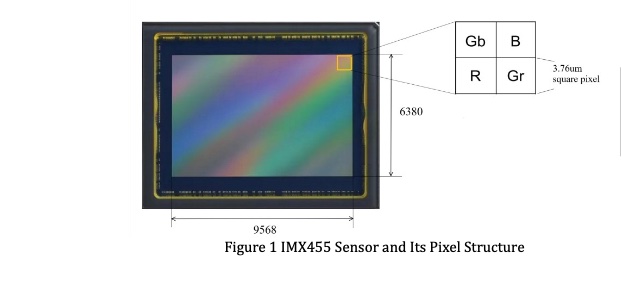
Sony IMX455 Sensitivity

The sensor sensitivity of the SkyEye62AC is 484.18mV at 1/30s. Sensitivity is measured using a test standard lens with CM500S (t = 1.0mm) as IR cut filter and an image at F8.0.
16Bit ADC and ROI
The SkyEye62AC has built in 16bit ADC. It also has 12bit output mode for hardware binning and smaller resolution. The camera also supports hardware ROI, and the smaller the ROI size is, the faster frame rate is.
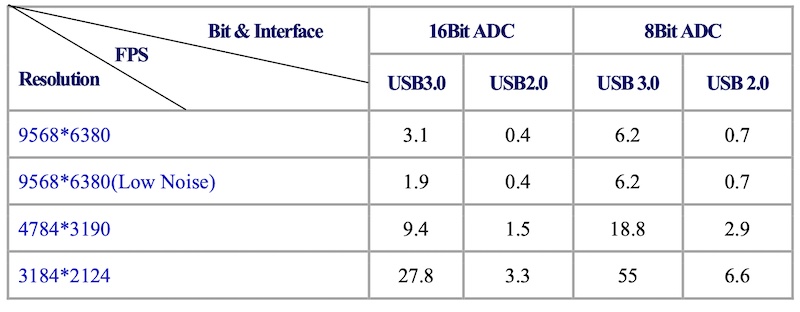
DD3 Buffer
SkyEye62AC camera has a 512MB (4Gb) DDR3 buffer, which helps maintain the stability of data transmission, because image data can be temporarily buffered without being sent hastily to the receiver.
Binning
The SkyEye62AC supports digital binning from 11 to 88 in either stacking or averaging method, and hardware binning from 11 to 33 in averaging method. Hardware pixel binning is much faster than software binning.
Conversion Gain Switch
SkyEye62AC supports HCG and LCG mode switch. Under LCG mode, the full well can reach 107ke-.
Camera Performance Analysis
Camera performance can be evaluated with e-/ADU, Read Noise, Full Well and Dynamic Range.
e-/ADU: The sensors found in cameras used for vision applications have pixels that convert incoming photons into electrons. Gain on a CCD /CMOS camera represents the conversion factor from electrons (e-) into digital counts, or Analog- Digital Units (ADUs). Gain is expressed as the number of electrons that get converted into a digital number, or electrons per ADU (e-/ADU).
Read Noise: Read Noise is the most important reference to measure the performance of a camera. Lower read noise usually means better SNR and better quality of image. Read Noise is created within the camera electronics during the readout process as the electrons are subjected to the analog to digital conversion, amplification and processing steps that enable an image to be produced.
Full Well: The electrons are held in each pixel and are converted into electrical charge which can be measured to show the amount of light that has fallen on each pixel. The maximum electrical charge possible is termed "full well capacity". Under the same conditions such as noise and A/D converter quality, the greater full well capacity a sensor has, the wider dynamic range the sensor has. As there is a limit to the depth to which pixels can be made, the full well capacity is often proportional to the frontal area of the light gathering element of the pixel.
Dynamic Range is the ratio between the maximum output signal level and the noise floor at minimum signal amplification (noise floor which is the RMS (root mean square) noise level in a black image). The noise floor of the camera contains sensor readout noise, camera processing noise and the dark current shot noise. Dynamic range represents the camera’s ability to display/reproduce the brightest and darkest portions of the image and how many variations in between. This is technically intra-scene dynamic range. Within one image there may be a portion that is in complete black and a portion that is completely saturated.
HCG-Mode

Abb.: Sensor Analysis Data in HCG Mode
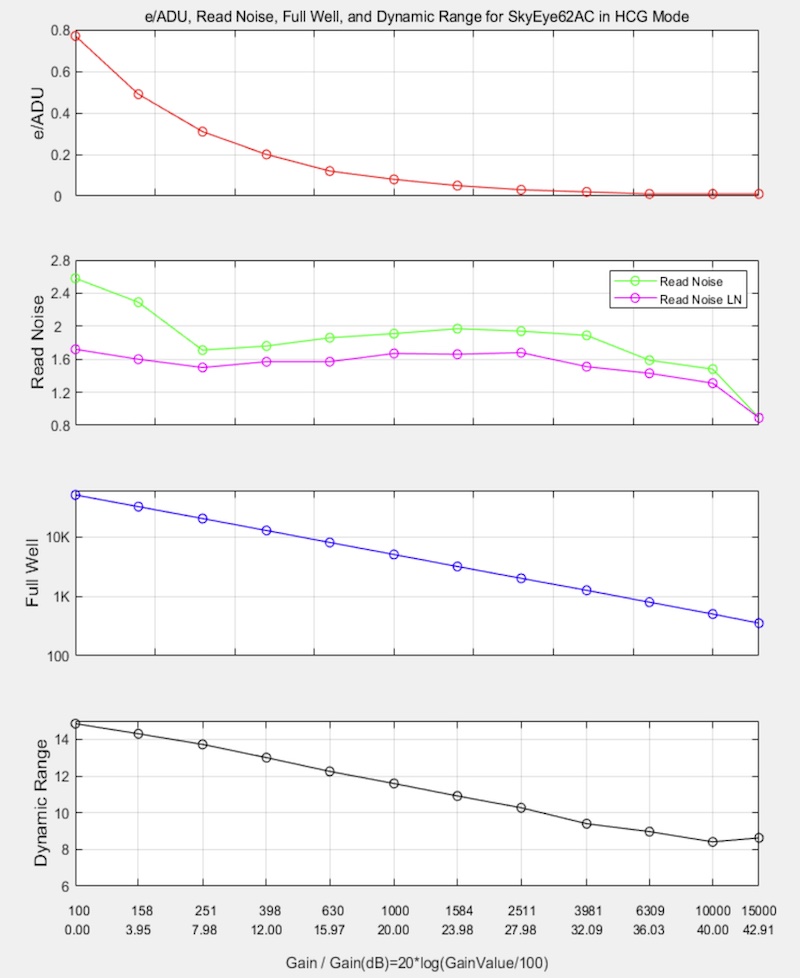
Abb: Read Noise, Full Well, Relative Gain, Dynamic Range for SkyEye62AM
LCG-Mode

Abb.: Sensor Analysis Data in LCG Mode

Abb: Sensor Analysis Result in LCG Mode
Zero Amp-Glow

The SkyEye62AC has been carefully designed and is able to achieve zero amp-glow photo shooting. Figure 3 and Figure 4 show the different cameras at 20C and 5-minute exposure time with and without amp-glow. One can find that SkyEye62AC captured image has zero amp-glow.
Packing List

A: 3-A safety equipment case: L:26.2cm W:24.0cm H:12.4cm (1pcs, 3.9Kg/ box)
B: SkyEye camera (M54Fx0.75 mount)
C: Power adapter: input: AC 100~240V 50Hz/F60Hz, output: DC 12V 3A
D: High-Speed USB3.0 A male to B male gold-plated connectors cable /1.5m
E: CD (Driver & utilities software, Ø12cm)
F: Hex wrench H 2.0
G: M54M-M48F 21mm extender
H: M48M-M48F 16.5mm extender
I: M48M-M42F adapter
Camera-Dimensions
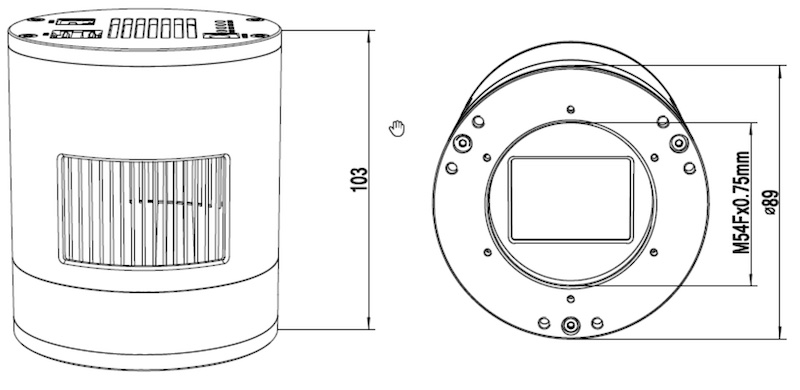
Camera-Connections

1 Protective window, 39 27 1.1mm, AR window for mono camera, IR-cut for color camera
2 M54F x 0.75 thread
3 Air inlet
4 Thermo outlet
5 USB 2.0 HUB
6 USB 3.0/ USB 2.0 port
7 DC 12V 3A power port, 5.5 2.1mm
8 LED indicators: 1) Power LED. 2) System LED. 3)TEC LED. 4)Fan LED
Camera Mechanical Connection with Adapter
The SkyEye62AC can be connected to a telescope with proper adapter, or the camera lens. The most common adapters are already included in the package, but we also provide some specific adaptors based on the requirement.
The female flange to the sensor is 17.5mm. User can make it to 55mm back focus distance with the 21mm and 16.5mm extender included in the camera package.

Camera Mechanical Connection with Lens

1 Nikon-M54 adapter
2 EOS-M54 adapter
3 Nikon lens
4 Canon lens
5 SkyEye camera with M54Fx0.75 mount
Camera Tilt Adjustment
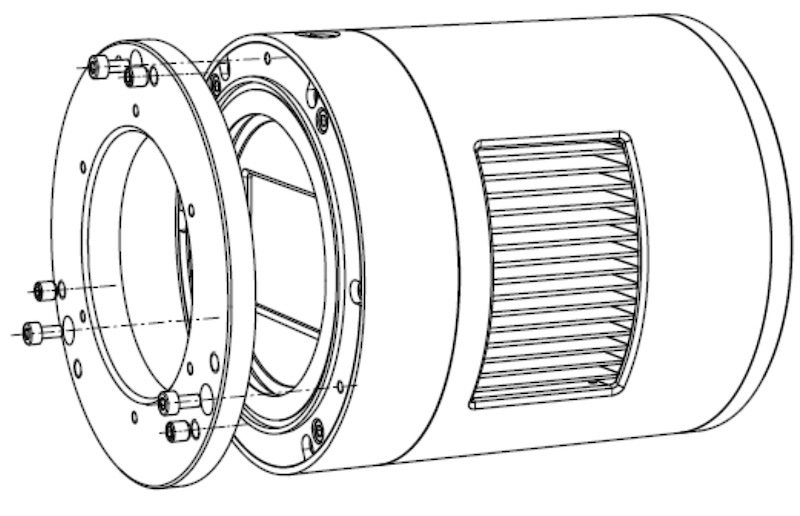
Instructions:
- Take a starred image with the camera, user can easily find out the tilt part in the image through the software, and then adjust one or more sets of flange adjustment screws on the camera corresponding to the imaging result.
- Take another image after the sensor tilt adjustment, and compare it with the previous one in the software. If the tilt issue is reduced, that means the adjustment is correct. Otherwise, the adjustment is wrong.
- Repeat step 2 until the stars in all corners are perfect.
SkyEye62AC and Its Software
Application Installation
For software, customers are welcomed to go to the software website: https//touptek.com/download/ , to download the latest ToupSky. The SkyEye can also be used with ASCOM, DirectShow SDK. If the third-party software is compatible with these SDK, customers can also download the software driver from our website and install the drivers into the third-party software.
SkyEye62AC and the 3rd Party Software

Calculated compatibility with popular telescopes
|
Seeing good (FWHM 1-2”) |
Seeing okay (FWHM 2-4”) |
|
C6 ideal C8: ideal RASA 8 undersampling C9.25 slight oversampling C11 slight oversampling RASA11 undersampling c14 slight oversampling GSO 8 f/5 ideal Esprit 80 ED slight undersampling Esprit 100 ED slight undersampling Esprit 120 ED ideal 150 PDS ideal 200 PDS ideal 250 PDS ideal Heritage 150 slight undersampling Skymax127 ideal |






